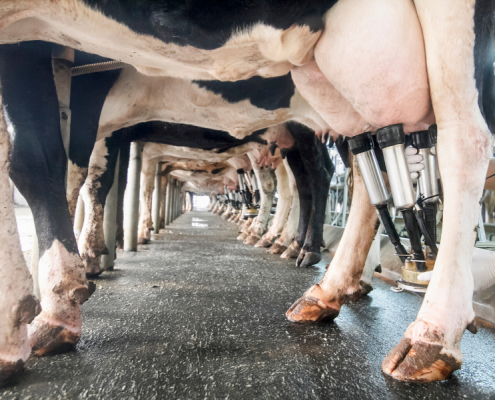Heat stress in dairy cows
Challenges for the dairy industry in Asia
What is heat stress in dairy cows? Heat stress in dairy cows is the point at which the animal cannot dissipate enough heat to maintain normal body temperature. The level of heat stress and its effect on the animal is influenced by three components:
- Ambient temperature
- Relative humidity
- Duration of the first two components throughout the day
It is important to note this because heat stress is not purely temperature related. Reduction in dry matter intake and milk production has been recorded in dairy cows at moderate temperatures, as low as 20°C, where humidity is a factor.
Duration is also a factor. In some climates, even though temperature and humidity may be challenging during the day, the animal gets metabolic relief at night. It then compensates by increasing its intake during this period.
Looking at the data in the tables, one quickly realises that when we consider most regions of mainland Asia, heat stress impacts dairy farming continuously. In fact, heat stress is probably the most significant challenge to dairy production, whether we are in the tropics, sub-tropics, or the desert environment in the Middle East. However, each climatic zone presents a different heat stress challenge and therefore, there is not a single solution to this problem.

Indication of the impact of heat stress on dairy cows without the effect of duration.

Temperature Humidity Index (THI) combines temperature and relative humidity to determin the heat stress factor.

The range of impact on milk production caused by the combination of temperature, humidity, and duration.
What determines the severity of heat stress in dairy cows?
When we look at the factors which impact the severity of heat stress in dairy cows, it is apparent that if we break Asian climatic zones down in their simplest form, the heat stress challenge is as follows:
- Sub-tropics: heat stress is seasonal, with the summer months and monsoon season being a period of extremely high THI for prolonged periods, with high temperatures and humidity during the day and higher humidity at night. This has led to an almost seasonal calving pattern on many farms.
- The Middle East: the challenge of extremely high temperatures during the day with a significant drop at night allowing for metabolic recovery. However, as we get close to the coast, humidity increases and duration of THI increases in the summer months.
- Tropics: this is the most challenging heat stress zone for dairy cows. THI remains high throughout the day and night and throughout the year.
Some of the main factors that influence heat stress in dairy cows are:
- cow factors (size, milk production)
- actual temperature and humidity
- degree of cooling that occurs at night
- length of the heat stress period
- management, cow comfort
- ventilation and air flow
- water availability
- nutrition
What happens in the dairy cow during heat stress?
By understanding the physiological and metabolic changes that occur in the dairy cow in response to heat stress, we can better prepare to alleviate its impact.
The image shows the cascade effect on the dairy cow as she responds to increased THI:
- Blood flow to the organs and digestive tract is reduced as it increases to the skin to improve cooling
- Dry matter intake (DMI) and metabolic activity reduce as a result
- Fibre digestion becomes impaired, rate of passage slows down, and intake reduces even further
- As respiratory rhythm and heartbeat increase, circulating carbon dioxide reduces. Hence, carbonic acid in the blood reduces and bicarbonate increases. The kidneys, to prevent blood alkalosis, removes quantities of circulating bicarbonate. This results in disruption of the body’s natural buffering mechanism
- This further reduces fibre digestion, DMI and leads to rumen acidosis
The process is cumulative. The impact on production, reproduction, and health increases unless this metabolic disruption is reversed.

Dairy cow heat stress metabolic reaction cascade
Heat stress and the effect on milk production
As dry matter intake reduces, milk production falls. As rumen pH tends towards 5.8 and below for extended periods throughout the day, rumen acidosis occurs. Hence, milk butterfat falls, milk protein falls, and fibre digestion decreases further. These observations have been measured again and again in regions where there are distinct seasonal changes (see graphs).
The problem in the regions we are discussing, is that an environment of heat stress is often the starting point when assessing the challenge rather than a seasonal challenge to be addressed.
Heat stress in dairy operations throughout Asia is not simply a seasonal challenge. It is one of the key determinants of every decision in the planning, management, reproduction, and nutrition of the dairy herd.

Heat stress reduces the milk production of dairy cows

Heat stress reduces the milk protein percentage

Heat stress reduces the milk butterfat percentage
Heat stress and the effect on reproduction & health
Reproduction
Heat stress has a significant negative impact on reproduction as follows:
- Decreased oestrus intensity and length
- Fertility rate decreases
- Ovarian follicle growth decreases
- Increased early embryonic death
- Impaired foetal growth
As a result, many herd owners have opted for cross-bred cows, or cows with lower production potential to maintain reproduction rates. The reality is that all dairy cows suffer in heat stress situations. Hence, it is more important to explore ways to reduce the impact of heat stress than dilute the genetic capability of the herd!
Health
Heat stress presents dairy cows with the following health challenges:
- Increased metabolic disorders
- Increased SCC and mastitis
- Increase in lameness especially laminitis
- Impaired immune function
It is important when planning any dairy operation in Asia to build into the economic budget the cost of reduced milk production, impaired reproductive performance, and the impact of health challenges on longevity. Only then can the cost and the value of environmental control be evaluated.
How to manage heat stress in dairy cows?
Controlling the environment
Alleviating the effects of heat stress on dairy cows by controlling their environment involves finding effective methods of reducing the animal’s body temperature without negatively impacting her comfort. It is that simple!
Designing barns and facilities to achieve this must be based on where in the world this farm is situated. The three environmental factors; temperature, humidity, and duration determine both the design of any barn and the cooling methods employed.
We know there are successful large dairy operations in desert areas that are averaging 40 litres with temperatures reaching well over 40°C. We also know that if we replicate these farms in coastal areas or particularly in the tropics, the results will be significantly less milk, combined with impaired reproduction and poor dairy herd health.
It is beyond the scope of this article to elaborate on specifics of facility design and methods to control dairy cow temperature in different climates. However, it is important to point out that design mistakes at the planning stage, based on the assumption that “if it worked there it should work here” have often proved very costly.
Whether one is investing in a new dairy or re-aligning a current operation, the best approach is to get the advice of a professional dairy project management team with experience in and understanding of the region and climate.
How to manage heat stress in dairy cows?
Dairy Nutrition
If climate control is insufficient for the dairy cow to maintain normal body temperature, then the cascade outlined earlier is inevitable. In combination with reduced DMI the rumen undergoes the following changes:
- Alteration in fermentation pattern and VFA production
- Feed stagnation
- Less rumen contractions
- Lower rumen pH
- Decreased rumen microflora number and activity
- Reduced fermentation of forage fibre leads to excess in NH3 and reduced rate of passage
- Synchronisation of CHO-protein suffers

Rumen acidosis damages rumen papillae
Nutritional solutions to reduce the impact of heat stress
It must be emphasised that unless effective climate control facilitates the animal’s ability to maintain normal body temperature, adjusting the dairy cow’s diet will not eliminate the physiological and metabolic impact of heat stress resulting in reduced fertility, increased mastitis and metabolic disorders. Dietary adjustments can compensate for the detrimental changes in rumen function.
- Feeding strategy is essential in heat stress situations
- Dairy cows will adjust their behaviour to eat more during periods of the day with lower THI. Feed availability should reflect this
- Dairy cows will sort TMRs more during heat stress. Mixing, forage chop length, moisture content and pushing up feed all become critical during this time
- Reduced fibre digestibility in heat stress affects intake, rate of passage, microbial protein synthesis, CHO-protein synchrony and increases acidosis risk
- Feeding forages with the highest digestibility during heat stress. This is a critical point to be considered for the future of dairies in mainland Asia where heat stress is often continuous and forage digestibility is well below optimum. Improving forage quality must be an ongoing goal for dairy farming to be sustainable throughout the continent
- Reducing the quantity of forage. Reducing forage in the diet and increasing the concentrate to forage ratio can increase the energy density of the total diet and offset some of the reduced dry matter intake. But it also increases the risk of acidosis.
- Increasing fibre fermentation rate in the rumen
- Reduced rumen function impairs the flow of microbial protein into the abomasum and increases the amount of NH3 not captured in microbial protein resulting in elevated blood urea levels. Reducing the degradability of the protein fraction in the ration can improve the flow of amino acids and peptides for milk production and maintenance while reducing the production of ammonia
- Increasing the quantity of rumen inert fats to increase the total energy density of the ration helps to reduce mobilisation of body reserves and supplies pre-formed fatty acids for butterfat production. When formulating these into the diet, be conscious of the total fat coming from all ingredient sources in the diet. There is a point where added fat, including fractionated fats and calcium salts, impair fibre digestion and reduce butterfat production
- Heat stress in dairy cows is exactly that – stress! The animal’s immune system is under sustained stress. This is one of contributing factors to increased metabolic disorders, mastitis, and impaired reproduction. Formulation of the mineral/vitamin premix should reflect this:
- The level and source of vitamin E, selenium and zinc are critical. Organic chromium is an important addition to the trace element nutrition of dairy cows in heat stress
- Ensure there is sufficient sodium in the formulation. The addition of potassium carbonate helps maintain cation/anion homeostasis as the body loses essential salts
The rumen tends towards acidosis in heat stress. Some of the changes in the diet exacerbate this. The challenge is where rumen pH falls below 5.8 for prolonged periods throughout the day, impairing fibre digesting organisms. The traditional approach of buffering high concentrate diets with sodium bicarbonate does not effectively alleviate this. It quickly gets used up in the rumen post feeding and in heat stress, where natural buffering from saliva is limited, there is a need to effectively maintain pH beyond the post feeding spikes to assist fibre digestion. The addition of
CalMinProMinAcid Bufmeets this need while supplying bioavailable calcium and magnesium
Conclusions
In summary, heat stress is one of the greatest challenges to developing an economically sustainable dairy industry based on high producing dairy cows throughout mainland Asia. However, we have learned to address this challenge. As industry professionals we are now at the point where correct facility design, environmental control, management, and nutrition can combine to overcome this challenge.
This article is a courtesy of Progressive Dairy Solutions, Inc.
- Reduce the risk for rumen acidosis
How? Get powered by our science here
- Increase fibre digestion
How? Get powered by our science here
- Improve feed efficiency
How? Get powered by our science here
- Drive dairy performance
How? Get powered by our science here
- Cover the need for essential minerals
How? Get powered by our science here
Related articles
 https://celticseaminerals.com/wp-content/uploads/2021/02/Transition-cow-Acid-Buf-CSM-800x600-1.png
600
800
Patricia
https://celticseaminerals.com/wp-content/uploads/2020/01/Celtic_13.png
Patricia2021-02-08 15:05:032023-03-02 13:35:35Transition Cow Management
https://celticseaminerals.com/wp-content/uploads/2021/02/Transition-cow-Acid-Buf-CSM-800x600-1.png
600
800
Patricia
https://celticseaminerals.com/wp-content/uploads/2020/01/Celtic_13.png
Patricia2021-02-08 15:05:032023-03-02 13:35:35Transition Cow Management https://celticseaminerals.com/wp-content/uploads/2020/11/CSM-CeltiMin-layers-featured-image-webpage-800x600-1.png
600
800
Patricia
https://celticseaminerals.com/wp-content/uploads/2020/01/Celtic_13.png
Patricia2020-11-03 15:41:302023-03-02 13:36:21How to prevent eggshell quality problems?
https://celticseaminerals.com/wp-content/uploads/2020/11/CSM-CeltiMin-layers-featured-image-webpage-800x600-1.png
600
800
Patricia
https://celticseaminerals.com/wp-content/uploads/2020/01/Celtic_13.png
Patricia2020-11-03 15:41:302023-03-02 13:36:21How to prevent eggshell quality problems? https://celticseaminerals.com/wp-content/uploads/2020/09/CSM-featured-image-gastric-pH-800x600px.png
600
800
Patricia
https://celticseaminerals.com/wp-content/uploads/2020/01/Celtic_13.png
Patricia2020-09-20 15:10:092023-03-02 13:36:48How gastric pH affects pig gut health
https://celticseaminerals.com/wp-content/uploads/2020/09/CSM-featured-image-gastric-pH-800x600px.png
600
800
Patricia
https://celticseaminerals.com/wp-content/uploads/2020/01/Celtic_13.png
Patricia2020-09-20 15:10:092023-03-02 13:36:48How gastric pH affects pig gut health https://celticseaminerals.com/wp-content/uploads/2020/07/CSM-featured-image-heat-stress-asia.png
600
800
Patricia
https://celticseaminerals.com/wp-content/uploads/2020/01/Celtic_13.png
Patricia2020-07-28 08:45:572023-03-02 13:38:15Heat stress in dairy cows
https://celticseaminerals.com/wp-content/uploads/2020/07/CSM-featured-image-heat-stress-asia.png
600
800
Patricia
https://celticseaminerals.com/wp-content/uploads/2020/01/Celtic_13.png
Patricia2020-07-28 08:45:572023-03-02 13:38:15Heat stress in dairy cows https://celticseaminerals.com/wp-content/uploads/2020/06/CSM-featured-image-feed-efficiency-800x600px.png
600
800
Patricia
https://celticseaminerals.com/wp-content/uploads/2020/01/Celtic_13.png
Patricia2020-06-30 12:28:302023-03-02 13:39:19Improving feed efficiency in dairy cows
https://celticseaminerals.com/wp-content/uploads/2020/06/CSM-featured-image-feed-efficiency-800x600px.png
600
800
Patricia
https://celticseaminerals.com/wp-content/uploads/2020/01/Celtic_13.png
Patricia2020-06-30 12:28:302023-03-02 13:39:19Improving feed efficiency in dairy cows https://celticseaminerals.com/wp-content/uploads/2020/06/CSM-featured-image-piglets-sleeping-800x600px.png
600
800
Patricia
https://celticseaminerals.com/wp-content/uploads/2020/01/Celtic_13.png
Patricia2020-06-23 15:33:152023-03-02 13:40:54How to reduce pig aggression?
https://celticseaminerals.com/wp-content/uploads/2020/06/CSM-featured-image-piglets-sleeping-800x600px.png
600
800
Patricia
https://celticseaminerals.com/wp-content/uploads/2020/01/Celtic_13.png
Patricia2020-06-23 15:33:152023-03-02 13:40:54How to reduce pig aggression? https://celticseaminerals.com/wp-content/uploads/2020/06/CSM-featured-image-beef-cattle-charolais-800x600px.png
600
800
Patricia
https://celticseaminerals.com/wp-content/uploads/2020/01/Celtic_13.png
Patricia2020-06-16 07:25:322023-03-02 13:41:17Fiber digestion drives beef cattle performance
https://celticseaminerals.com/wp-content/uploads/2020/06/CSM-featured-image-beef-cattle-charolais-800x600px.png
600
800
Patricia
https://celticseaminerals.com/wp-content/uploads/2020/01/Celtic_13.png
Patricia2020-06-16 07:25:322023-03-02 13:41:17Fiber digestion drives beef cattle performance Celtic Sea Minerals
https://celticseaminerals.com/wp-content/uploads/2020/06/CSM-featured-image-dairy-cow-neville-800x600px.png
600
800
Patricia
https://celticseaminerals.com/wp-content/uploads/2020/01/Celtic_13.png
Patricia2020-06-01 20:53:282023-03-02 13:44:46How a rumen buffer drives dairy performance
Celtic Sea Minerals
https://celticseaminerals.com/wp-content/uploads/2020/06/CSM-featured-image-dairy-cow-neville-800x600px.png
600
800
Patricia
https://celticseaminerals.com/wp-content/uploads/2020/01/Celtic_13.png
Patricia2020-06-01 20:53:282023-03-02 13:44:46How a rumen buffer drives dairy performance https://celticseaminerals.com/wp-content/uploads/2020/05/CSM-featured-image-holstein-cow-gras-800x600px.png
600
800
Patricia
https://celticseaminerals.com/wp-content/uploads/2020/01/Celtic_13.png
Patricia2020-05-24 21:54:212023-03-02 13:45:11How to reduce the risk for grass staggers?
https://celticseaminerals.com/wp-content/uploads/2020/05/CSM-featured-image-holstein-cow-gras-800x600px.png
600
800
Patricia
https://celticseaminerals.com/wp-content/uploads/2020/01/Celtic_13.png
Patricia2020-05-24 21:54:212023-03-02 13:45:11How to reduce the risk for grass staggers? https://celticseaminerals.com/wp-content/uploads/2020/05/CSM-featured-image-pig-nose-800x600px.png
600
800
Patricia
https://celticseaminerals.com/wp-content/uploads/2020/01/Celtic_13.png
Patricia2020-05-12 22:21:192023-03-02 13:46:30How to prevent gastric ulcers in pigs?
https://celticseaminerals.com/wp-content/uploads/2020/05/CSM-featured-image-pig-nose-800x600px.png
600
800
Patricia
https://celticseaminerals.com/wp-content/uploads/2020/01/Celtic_13.png
Patricia2020-05-12 22:21:192023-03-02 13:46:30How to prevent gastric ulcers in pigs? Celtic Sea Minerals
https://celticseaminerals.com/wp-content/uploads/2020/04/CSM-Iceland-Marine-Minerals.png
600
800
Patricia
https://celticseaminerals.com/wp-content/uploads/2020/01/Celtic_13.png
Patricia2020-04-20 07:15:212023-03-02 13:48:33Marine Minerals Nutrition Platform
Celtic Sea Minerals
https://celticseaminerals.com/wp-content/uploads/2020/04/CSM-Iceland-Marine-Minerals.png
600
800
Patricia
https://celticseaminerals.com/wp-content/uploads/2020/01/Celtic_13.png
Patricia2020-04-20 07:15:212023-03-02 13:48:33Marine Minerals Nutrition Platform Celtic Sea Minerals
https://celticseaminerals.com/wp-content/uploads/2020/04/CSM-dairy-cow-udder-milk-fat.png
600
800
Patricia
https://celticseaminerals.com/wp-content/uploads/2020/01/Celtic_13.png
Patricia2020-04-19 18:50:522023-03-02 13:47:30How to increase butterfat in dairy cows?
Celtic Sea Minerals
https://celticseaminerals.com/wp-content/uploads/2020/04/CSM-dairy-cow-udder-milk-fat.png
600
800
Patricia
https://celticseaminerals.com/wp-content/uploads/2020/01/Celtic_13.png
Patricia2020-04-19 18:50:522023-03-02 13:47:30How to increase butterfat in dairy cows? Celtic Sea Minerals
https://celticseaminerals.com/wp-content/uploads/2020/02/koe2.jpg
600
800
Patricia
https://celticseaminerals.com/wp-content/uploads/2020/01/Celtic_13.png
Patricia2020-02-14 21:43:062023-03-02 13:47:50How to prevent rumen acidosis?
Celtic Sea Minerals
https://celticseaminerals.com/wp-content/uploads/2020/02/koe2.jpg
600
800
Patricia
https://celticseaminerals.com/wp-content/uploads/2020/01/Celtic_13.png
Patricia2020-02-14 21:43:062023-03-02 13:47:50How to prevent rumen acidosis?You want to get powered by our science?

Strand Farm
Curraghbinny
Carrigaline
Co.Cork
P43 NN62, Ireland
T: +353 21 437 8377
E: info@celticseaminerals.com
Our marine minerals are fully compliant with the following globally recognised quality assurance schemes:



